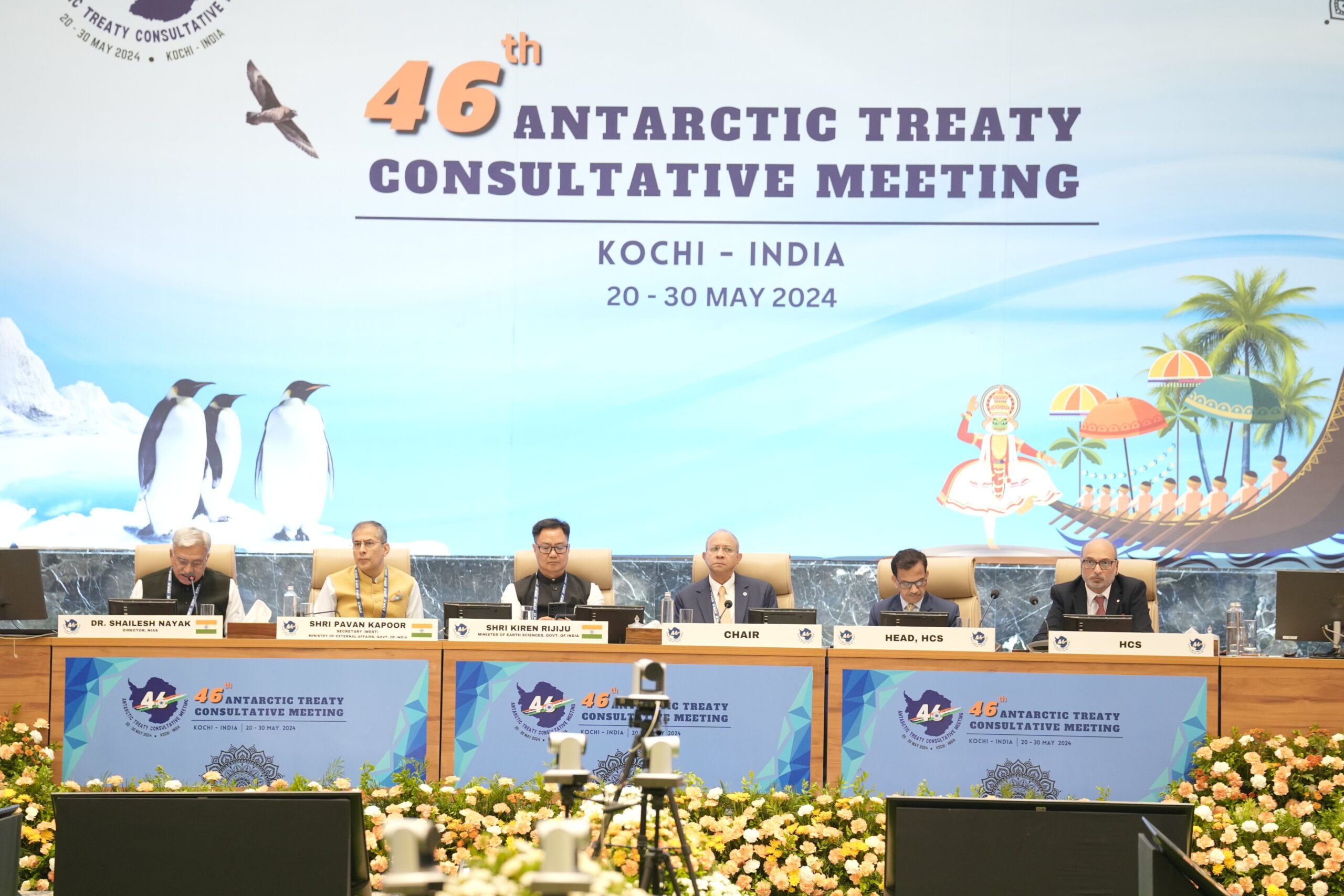Published in Eurasia Review, 4 June 2024
The 46th Antarctic Treaty Consultative Meeting (ATCM-46), held in Kochi (in the southern Indian state of Kerala) from May 20 to 30, 2024 and hosted by the Ministry of Earth Sciences, Government of India through the National Centre for Polar and Ocean Research (NCPOR), was anticipated to yield concrete measures for the governance of Antarctic activities. India, as the host, had high expectations for a significant breakthrough. Despite extensive discussions and a high level of engagement, the meeting revealed major hurdles and highlighted the ongoing challenge of reaching consensus on key issues, such as developing a comprehensive framework for regulating tourism and non-governmental activities. This situation reflects the historical difficulties faced by the ATCM, where many strategic policy questions remain unresolved due to the consensus rule.
However, the discussions at ATCM-46 demonstrated a broad understanding of the interconnectedness of global and polar ecosystems. The meeting’s outcomes also brought to light the critical challenges of balancing national interests, scientific research, and environmental protection in a rapidly changing world. The need for a more strategic and proactive approach to Antarctic tourism and environmental management is evident, necessitating continued international cooperation and negotiation.
Why tourism is a major challenge?
Since the early 1990s, tourism in Antarctica has grown significantly. Between 1992 and 2020, the number of tourists increased ten-fold, reaching 75,000 in the 2019-20 season and 104,897 in the 2022-23 season.
Jen Rose Smith explains that managing the impacts of Antarctic tourism is a complex task. Since no single national government controls Antarctica, its governance is managed by the Antarctic Treaty, which has been in effect since 1961. Regulating activities in Antarctica is more akin to addressing the issue of space debris orbiting Earth than managing tourism in locations like Barcelona or Easter Island. Peter Carey, a global fellow at the Polar Institute of the Wilson Center, notes, “We have numerous entities with geopolitical interests collaborating to oversee this vast part of the globe, making it difficult for a single voice to dominate. The challenge lies in getting all 55 parties to agree on a unified approach.”
Antarctic tourism has both positive and negative impacts. While it can inspire and educate the public, fostering support for the continent’s protection, it also has a high carbon footprint, damages visitor sites, disrupts wildlife, and causes penguins to change their reproductive and social behaviours.
Measures are needed to protect Antarctica from tourism impacts, but gaps exist in the current governance frameworks. The Antarctic Treaty System (ATS) and The Madrid Protocol provide broad rules for tourism, but day-to-day management is mostly self-regulated by the industry through the International Association of Antarctica Tour Operators (IAATO). Many researchers and conservation organizations believe self-regulation is insufficient to protect Antarctica’s wildlife and ecosystems.
As the tourism industry grows and diversifies, its negative environmental impacts are likely to increase, compounded by climate change. Reduced sea ice and increased ice-free land allow tourists to visit previously inaccessible places and extend the tourist season. These impacts threaten Antarctica’s unique biodiversity and its role in regulating the global climate.
Effective management of Antarctic tourism requires proactive, science-based decisions, cooperation among stakeholders, and thorough research to inform policies. Visitor sites and activities should be evaluated using the precautionary principle, and new safeguards may be needed, such as stronger protections within the ATS or specific management plans for protected areas.
Continuous monitoring of tourism impacts is essential to refine protections. Governments, research funders, and the tourism industry should support these efforts. Researchers should develop indicators that reflect wider impacts on biodiversity and ecosystems, and enhance tourism’s positive impacts through conservation education and citizen science programmes.
As tourism in the Antarctic region increases, environmental protection organizations are calling for urgent countermeasures, especially given the severe impacts of climate change. The International Union for Conservation of Nature (IUCN) noted the significant surge in Antarctic tourism since the early 1990s.
Claire Christian, head of the Antarctic and Southern Ocean Coalition (ASOC)—the only non-governmental organization allowed to attend the Antarctic Treaty Consultative Meeting (ATCM)—stressed that “formal regulation of tourism has been delayed for too long.” She highlighted that the ATCM-46 would present a critical opportunity to adopt enforceable regulations to protect Antarctica’s biodiversity. ASOC noted that the rise in tourists and research stations contributes to increased microplastics and wastewater in Antarctic waters, exacerbating the region’s deteriorating condition. Rapidly melting sea ice, heavily overexploited fish stocks, and the recent detection of avian influenza, all pointed to the urgency of addressing these environmental challenges.
At the ATCM- 46, countries did not adopt a framework to regulate tourism in Antarctica but committed to developing one in the near future. They agreed to create an “ambitious, comprehensive, flexible, and dynamic framework” for regulating tourism and non-governmental activities.
The ATCM is an annual meeting that promotes international collaboration on scientific research and sustainable resource management in Antarctica, adhering to the principles and objectives of the Antarctic Treaty established in 1961. This Treaty, which now includes 56 parties, mandates the peaceful use of Antarctica and the freedom of scientific investigation and information exchange.
On the opening day of the ATCM, India announced the formation of a special working group dedicated to creating a tourism framework for Antarctica. Ricardo Roura, senior advisor for the Antarctic and Southern Ocean Coalition (ASOC), noted that most discussions focused on the commitment to develop this framework over the next 12 months and beyond, without making any substantive decisions yet. Roura highlighted that while some parties favoured minimal regulation, there was a general agreement to address the issue seriously.
Parties unanimously agreed on priority items to be discussed before the next ATCM meeting, including tourism growth and diversification, monitoring, compliance and enforcement, and governance. A document titled “Comprehensive and Consistent Framework for the Regulation of Tourism and Other Non-Governmental Activities in the Antarctic Treaty Area — Suggestions for a Framework Structure,” prepared by several countries, invited consultative parties to develop proposals to ensure thorough preparation for the discussions.
Roura emphasized that this marks the beginning of a long-term process and noted that the effectiveness of these discussions remains to be seen as tourism continues to grow and diversify.
Ricardo Roura stated that parties generally supported initiatives to share best practices, discuss definitions, and explore options for gray water management in future meetings. He noted that tourism industry representatives also showed a willingness to engage on this topic. Some parties expressed concern about the unknown environmental impacts of unregulated gray water disposal in the Antarctic Treaty Area and supported further scientific research in this area.
Antarctic Tourism Governance
Kees Bastmeijer et al. wrote a comprehensive article on the challenges to tourism regulation in American Journal of International Law. According to them, Antarctic tourism began in the 1960s with fewer than 1,000 tourists per season until the mid-1980s. Following the 1991 Protocol on Environmental Protection to the Antarctic Treaty, tourist numbers increased from 6,500 in 1991-1992 to 74,401 in 2019-2020. The COVID-19 pandemic caused a drop, but numbers rebounded to 104,897 in 2022-2023, a 40% increase from pre-pandemic levels. The number of SOLAS tourist vessels also grew from 37 to 50 over five years. IAATO estimates 118,089 tourists for the 2023-2024 season, a 12.5% increase.
Most tourists travel on small to mid-sized ships for 7–10-day trips with landings on the Antarctic Peninsula. Over 30% cruise without landings on larger ships, while less than 10% join fly-sail operations or private yachts. Land-based activities include mountain climbing and ski expeditions. Tourist activities must comply with the Protocol’s environmental principles, including prior environmental impact assessments and specific protections for flora, fauna, and special areas.
Although Antarctic tourism isn’t fully “unregulated,” existing Protocol provisions aren’t specific to tourism. A proposed tourism annex by five Consultative Parties in 1991 lacked consensus. Self-regulation by IAATO and the Protocol’s ratification were key factors. Since a 2004 expert meeting on tourism by Norway, discussions have increased, as Kees Bastmeijer and Neil Gilbert have noted this in another article, with Consultative Parties expressing concerns over cumulative environmental impacts, loss of pristine areas, potential interference with research, disruption of national programs, human safety, and search and rescue issues.
Many proposals from Consultative Parties at the Antarctic Treaty Consultative Meetings (ATCM) have focused on specific issues, leading to a fragmented approach. In 2009, the UK proposed a “strategic vision” for Antarctic tourism, but it failed to gain consensus, resulting in non-binding General Principles of Antarctic Tourism. Despite identifying 18 key questions in 2011-2012 and recognizing the need for a strategic approach in 2016 and 2017, ATCM discussions remained fragmented.
Between ATCM 44 (2022) and ATCM 45 (2023), some countries pushed for a comprehensive debate on Antarctic tourism. A 2023 Paris workshop led to working papers for ATCM 45, emphasizing the need for governance action due to tourism growth and diversification. Since 1991, ATCM has adopted one recommendation, two measures, and forty resolutions on tourism, but none of the measures have come into force due to lack of approval from all Consultative Parties.
Many substantive policy questions remain unanswered, including whether to adopt regulatory instruments to control tourism expansion. The consensus rule, requiring agreement from all Consultative Parties, has often hindered action. Proposals such as banning permanent tourism facilities or a comprehensive tourism vision have failed due to lack of consensus. Reasons for objections vary, including conflicts with domestic laws, sovereignty issues, and differing views on Antarctic principles.
Rising international tensions and the increasing number of Consultative Parties have further complicated decision-making. To address these challenges, it is essential to understand the true reasons for objections and find flexible compromises. The consensus rule’s limitations mean that without agreement to prohibit activities, they are effectively permitted if they comply with the Antarctic Treaty and Protocol, leading to “decision making by non-decision making.”
At the 44th Antarctic Treaty Consultative Meeting (ATCM) in Berlin in 2022, it was noted that tourism and non-governmental activities in Antarctica have been steadily increasing. The meeting recognized that tourism could interfere with scientific research, harm flora and fauna conservation, and cause lasting environmental damage. The need for concrete actions to monitor tourism impacts was emphasized to ensure sustainable tourism while protecting the Antarctic environment. The Committee for Environmental Protection (CEP) and the Scientific Committee on Antarctic Research (SCAR) were commended for their monitoring efforts. Several parties presented long-term national initiatives and projects collecting tourism data, which could serve as a foundation for coordinated monitoring programs.
Additional concerns included ensuring tourism had no more than a minor or transitory impact, maintaining safety, addressing increased air traffic implications, and cumulative impacts on wilderness values. New environmental threats posed by the growth and diversification of tourism and other non-governmental activities were also highlighted.
India stressed the strategic importance of addressing tourism issues, noting the ongoing discussion on gateway cities and port controls. Resolution 5 (2022) of the 44th ATCM, titled “Permanent Facilities for Tourism and Other Non-Governmental Activities in Antarctica,” reflects a consensus that tourism should be conducted safely without contributing to long-term environmental degradation. It acknowledged the International Association of Antarctic Tour Operators (IAATO) Bylaws, which stipulate that tourism should have no more than a minor or transitory impact. The resolution recommended that governments prevent and not authorize or approve the construction and operation of tourism-related structures or facilities that could have more than a minor or transitory impact on the environment, its ecosystems, or its intrinsic natural wilderness and historical values.
At the 45th ATCM held in Helsinki from May 29 to June 8, 2023, the continued rapid growth and expansion of Antarctic tourism was acknowledged as posing potential negative impacts on the environment and other protected values of Antarctica. Although the meeting began ambitiously, efforts to enhance tourism regulation largely stalled due to opposition from some countries against adopting strong precautionary measures. Nevertheless, tourism is expected to remain a high-priority issue at ATCM-46, where a special working group would focus on developing a comprehensive and consistent regulatory framework for tourism.
Despite the setbacks, some progress was made, including the establishment of a new Antarctic Specially Protected Area and a broad consensus on the importance of effective regulation for both shipping and tourism.
The discussions held so far indicate the crucial role of the consensus rule in Antarctic governance, highlighting both its importance and the challenges it poses in ensuring timely and effective international responses to the growth of Antarctic tourism. Despite the significant increase in tourism, serious concerns from Consultative Parties, numerous scientific publications on the environmental impacts, and comprehensive discussions at ATCMs based on numerous working papers and proposals, many strategic policy questions remain unresolved.
The ATCM’s inability to reach conclusions on key tourism issues is troubling, given the Protocol’s aim to ensure comprehensive protection of the Antarctic environment. This is particularly problematic because the lack of consensus does not merely delay decision making; it effectively permits activities to continue without regulation, potentially causing further harm to the fragile Antarctic ecosystem.
Plausibly, the current governance under the Antarctic Treaty System and the self-regulated International Association of Antarctica Tour Operators is inadequate for environmental protection. There is a need for more robust, science-based management involving stakeholders such as the tourism industry, researchers, conservation organizations, and governments. Effective management strategies are essential to mitigate tourism’s negative impacts. These include stronger protections, continuous monitoring, and more research on tourism’s ecological effects. Long-term efforts should focus on balancing tourism growth with the preservation of Antarctica’s unique biodiversity and ecosystem services.




